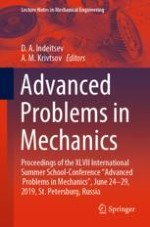This book focuses on original theories and approaches in the field of mechanics. It reports on both theoretical and applied research, with a special emphasis on problems and solutions at the interfaces of mechanics and other research areas. The respective chapters highlight cutting-edge works fostering development in fields such as micro- and nanomechanics, material science, physics of solid states, molecular physics, astrophysics, and many others. Special attention has been given to outstanding research conducted by young scientists from all over the world. Based on the 47th edition of the international conference “Advanced Problems in Mechanics”, held on June 24–29, 2019, in St. Petersburg, Russia, and organized by Peter the Great St. Petersburg Polytechnic University and Institute for Problems in Mechanical Engineering of Russian Academy of Sciences under the patronage of Russian Academy of Sciences, the book provides researchers and graduate students with an extensive overview of the latest research and a source of inspiration for future developments in various fields of mechanics.
